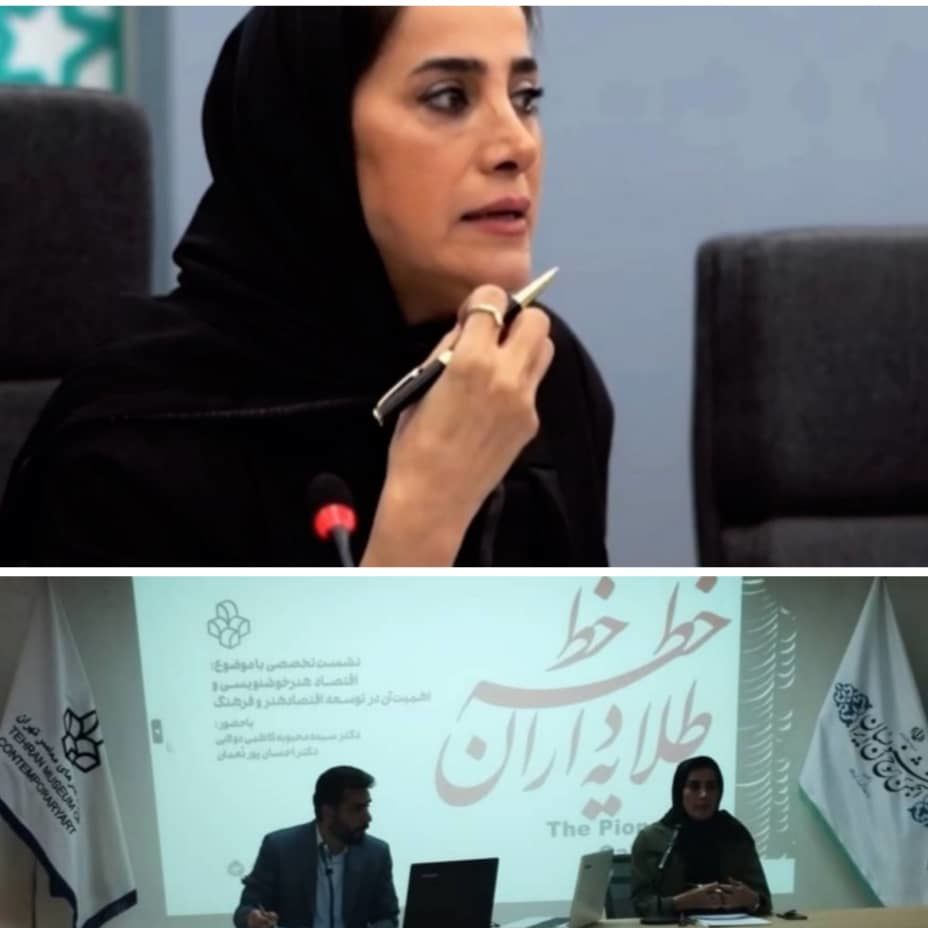Mahboubeh Kazemi Doulabi | Baran Auction | Taraneh Baran Gallery
Mahboubeh Kazemi Doulabi and The Middle Eastern Calligraphy Art Economy

During the special meeting "The Economics of Calligraphy Art and Its Contribution to the Advancement of Art and Cultural Economics" at the Tehran Museum of Contemporary Arts, Mahboubeh Kazemi Doulabi, the manager of the Taraneh Baran Gallery and the creator of the Baran Auction, a specialized auction of calligraphy and Islamic Iranian arts, highlighted infrastructure points.
IranArt : Sajjad Malmir: The words of Mahboubeh Kazemi Doulabi, the mind behind of the Baran Auction and director of the Taraneh Baran Gallery, are widely available lately on the internet, particularly on calligraphy-focused channels.
The Tehran Museum of Contemporary Art hosted a lecture on Tuesday, October 17, at which the topic was the economics of calligraphy in Iran and the Middle East. You are about to catch a portion of this speech.
- One of the typical seasons of people in the Middle East and abroad (the 57 Islamic countries) is calligraphy. The Quran serves as our sacred text, and calligraphy is what unites us. On this strategic art, we must supply accurate and strategic planning. For a long time, I've been looking for the Islamic World Calligraphy Expo and its specialized art fair, which I want to see happen soon.

- Based on the traditions of two major Iranian and Islamic civilizations, calligraphy and Iranian Islamic arts are among the most innovative and unique traditional arts in Iran. Furthermore, it is indisputable that calligraphy holds a unique place in the globe.
- In all artistic disciplines, collectors, gallery owners, auctioneers, and museum owners are the four primary foundations of the economics of art. All four of these foundations must function properly and in accordance with international norms for calligraphy to take its proper place, as seen from the perspective of the art market, in the Middle East and among Islamic nations.
- The Middle East needs a large number of influential, well-run calligraphy museums.
- To see a change in the marketing and promotion of calligraphy, we need professional, specialized auctions dedicated to the art form to be held in the Middle East. On this foundation, Baran Auction was founded in Tehran in 2016. To date, the event has had four runs, and each time has seen an incredible price increase.

- It is apparent that Iranian calligraphy art is comparable to a highly valuable treasure in the world's most renowned museums. Similarly, Islamic art pieces that are sold at Christie's, Sotheby's, Bonhams, and other auction houses consistently break records. However, a more proactive approach to calligraphy in the area is required. There needs to be a greater presence from galleries, collectors, etc.
- By mistake, there are those in our region who only want to see Western art flourish, but the world appreciates the native and true art forms of the Middle East, such as Islamic arts and calligraphy.
- One of the most successful strategies to boost the prosperity of calligraphy art and its museums in the area is the growth of art tourism.
- It is not necessary to provide evidence of the calligraphy community's creative human resource capacity. The largest creative association in Iran, the Iran Calligraphers Association, is unmatched in the Middle East. There are over two million calligraphers in Iran, and the venerable organization has 360 branches both domestically and abroad. Owing to its origins and past, calligraphy is regarded as a component of our nation's legacy, which has recently been registered globally.
- Iran and the region are suffering from a lack of modern calligraphic branding. While the market for seasoned calligraphers in the area is well-established and thriving, the middle and younger generations of calligraphers in Iran and the Middle East, despite their excellent caliber, are not recognized and have shunned the media and market.

- The market for calligraphy art, in my opinion, requires a customized intelligent trade that constantly assesses customer needs, promotional activities, and marketing. This means that if we only consider the supply, we won't do anything. However, if we create the appropriate environments, we may also raise the demand.
- An artwork from the realm of art turns into a commodity when it tries to enter the market and economy. Here, we must abide by the laws and norms of the market economy. When you respect the established elements of the market, you can be successful in the financial sector.
- Both the existence of well-known curators to host focused and varied programs and an active media landscape are necessary for the calligraphy art market to flourish.

